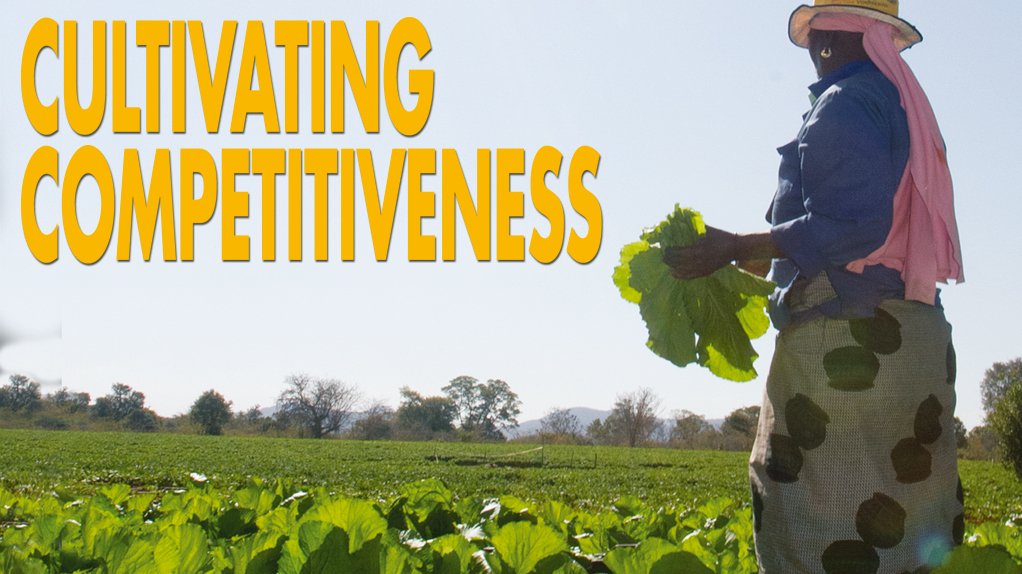Plan to bolster farm-supporting infrastructure starting to take shape
South Africa’s agriculture sector faces a number of serious challenges and constraints. The spatial-zoning policies enforced before and during apartheid resulted in the extreme marginalisation of black farmers and foresters. Secondly, domestic producers face stiff competition from low-priced imports, while their exports are often subjected to market-access restrictions. And, then there is still the critical question of land reform and redistribution, which continues to weigh on the sector’s prospects.
Nevertheless, there is also a growing realis-ation within government that the sector still offers material growth, rural development and employment opportunity.
Agri SA senior economist Dawie Maree says that land-reform beneficiaries struggle to establish themselves in the agricultural market because they tend to fall within the large stratum of smaller commercial farms.
Rural infrastructure challenges also hamper the competitiveness of South Africa’s agri- culture sector and the backlog of unequal development that has not been corrected yet has resulted in potentially productive land not being used optimally, which is contributing to rural unemployment and underemployment, explains Maree.
The Department of Rural Development and Land Reform (DRDLR) states that, since the inception of its Restitution Programme in 1995, 79 696 claims have been lodged and 77 334 settled. The state has acquired 1.4- million hectares of land and R16-billion has been spent on the programme so far.
“Between 2009 and March this year, 1 269 farms have been recapitalised, creating more than 7 400 jobs and the net income in December [2012] for these farms was R126-million,” said Rural Development and Land Reform Minister Gugile Nkwinti during the department’s Budget Vote speech in May.
A total of R2.7-billion will be spent on recapi- talising 552 farms and acquiring 170 000 ha of land and R3-billion will be spent on settling 438 land claims across the country.
The Minister further stated that R31-million would be invested in preparation for the implementation of the Spatial Planning and Land Use Management Bill once enacted and R68-million will be allocated to rural and poor municipalities.
Also, the department is investing R448-million in the development of its e-Cadastre system, which will enable a holistic view of land ownership across the country.
The department will invest about R240-million to revitalise irrigation schemes on 5 000 ha of land in Valhaarts, Taung, in the North West; five schemes in the uMkhanyakude, Uthungulu, Mzinyathi and Zululand districts, in KwaZulu-Natal; and three schemes, in the Eastern Cape.
The water irrigation systems need to be upgraded to ensure water is used as efficiently as possible because the effects of climate change make rainfall patterns unreliable, states the Agricultural Sector Strategic Skills Plan 2011-2016.
These challenges are set against the backdrop of increasing energy costs and a tendency towards greater centralisation of downstream agroprocessing capacity and distribution networks, explains Maree.
Storage and Logistics
Another key competitiveness-raising initiative in the sector is the Presidential Infrastructure Coordinating Council’s (PICC’s) Strategic Integrated Project 11 (Sip 11). The initiative is designed to improve agrologistics and rural infrastructure in an effort to stimulate the growth in the agricultural industry and, in so doing, create jobs and boost food security.
Such infrastructure investment is deemed necessary to reduce the costs of doing business for farmers, as well as for those businesses in the rest of the value chain. Key issues include transport costs, access to appropriately located and equipped storage and processing facilities, as well as the provision of accurate and timely information to the private sector and government, which will enable them to make more informed decisions.
Agriculture, Forestry and Fisheries Minister Tina Joemat-Pettersson said in her Budget Vote speech in May that the department planned to invest R663.9-million in administration, R4.554-billion in agriculture, R525.5-million in forestry and R43-million in fisheries to develop the sector’s market competitiveness.
Strategic Infrastructure
In addition, attention is being given to ensuring the Sip 11 moves towards implementation.
The programme is one of the 18 infrastructure initiatives being overseen by the PICC and comprises various individual projects. These include the expansion of storage and pro- cessing facilities for storage, improving transport links to main networks, installing farm fencing and irrigation schemes, improving research and development, expanding of agricultural colleges and improving forestry and fisheries infrastructure.
There appears to be general support for the initiative, but there are concerns over implementation, with Maree indicating that Sip 11 stood still for some time.
However, since the National Agricultural Marketing Council was appointed as the driver for the Department of Agriculture, Forestry and Fisheries-led (DAFF-led) initiatives, progress is reportedly being made.
It consists of seven high-level infrastructure imperatives, the first of which relates to primary production infrastructure (PPI).
Spending on the PPI is estimated to cost R21-billion until 2017 and it aims to unlock the potential of individual farmers, foresters and fishers by recovering the productive potential of infrastructure that has fallen into disrepair, as well as develop nontraditional subsectors such as aquaculture, Maree explains.
The PPI includes the rehabilitation of the irrigation schemes in the former homelands, particularly large schemes that have the potential to expand.
The bulk of government-funded infrastructure investment, in terms of the PPI, includes the Comprehensive Agriculture Support Programme.
This programme aims to provide post- settlement support for the targeted bene- ficiaries of land reform and other producers who have acquired land through private means and who are, for example, engaged in value-adding enterprises domestically or are involved in export.
Further, the DRDLR’s Recapitalisation and Development Programme aims to increase agricultural production, guarantee food security and job creation, as well as help small-scale farmers become commercial farmers.
Agroprocessing infrastructure, meanwhile, is expected to cost R2-billion over the coming three years and involves using incentives as a means of leveraging broad-based private- sector investment in new agroprocessing capacity. It will also assist in developing secondary cooperatives that cater to agro- processing and encourage out-grower schemes, in which a central processing facility serves as the nucleus for farmer development in an area.
Key interventions in the cropping subsector will include the improvement of bulk storage, grain milling, ginning for cotton, distilleries and biofuel plants to exploit and expand cane production, in KwaZulu-Natal and Mpumalanga, and grain production, in the Free State and North West.
The DAFF is responsible for import and export control of agricultural commodities and other biological products, as dictated by various national laws and international conventions. Currently, there is no centralised system in the country to keep track of such imports and exports, which has a severe impact on service delivery and biosecurity, with negative consequences for trade volumes.
To this end, the DAFF and the University of Pretoria Business Enterprises Unit did an analysis of the import-export value chains, including an analysis of the experiences and needs of import-export role players. The recommendation was that a centralised, digital information system would ensure that the import, export, transportation and storage of regulated items would comply with the basic statutory requirements.
The infrastructure investment activities within the agriculture and land reform sector are currently centred on production infrastructure, particularly for smallholder farmers and land-reform beneficiaries, says Maree.
A large portion of the investments are made by the three spheres of government in an effort to attract domestic and foreign investors.
The sector is developing a rolling three-year infrastructure plan, which encompasses the work of the DRDLR and DAFF and reflects ongoing activities, including irrigation scheme rehabilitation and new and proposed initiatives.
Therefore, existing agriculture-related programmes dealing with infrastructure investments have a direct bearing on Sip 11, thereby maintaining the conceptual basis and structure of Sip 11.
“To assist in getting down to specifics, while also encouraging co-investment from the private sector, there is a need to renew work on commodity strategies,” says Maree.
“There should be about four or five of them – for grains, livestock, subtropical fruit and others.”
These processes are geared for the needs of the large-scale and smallholder sectors and will assist in making coherent decisions about which and where infrastructure should be established.
Job Creation
As the primary economic activity in rural areas, agriculture has the potential to create about one-million new jobs by 2030.
Joemat-Pettersson also said during her Budget Vote speech in May that Statistics South Africa showed that agriculture was by far the largest contributor to job creation and must count as one of the country’s key successes.
“The sector has been able to sustain the growth recorded in the previous financial year,” she said. Nationally, the sector created 54 000 new jobs between January and March – an increase of 7.9%, and 12.7% year-on-year.
The sector currently employs 739 000 people, compared with 656 000 last year. Closer scrutiny of these figures shows that job growth was experienced in the provinces where a food-security intervention was implemented such as in the Eastern Cape, KwaZulu-Natal and Mpumalanga.
“If our modest attempts yielded such measur- able outcomes within such a short time, it demonstrates the potential impact that large-scale agricultural production could have on our economy,” Joemat-Pettersson said.
Small-scale farmers have the potential to create nearly 500 000 jobs and if redistribution beneficiaries employ themselves and two others, it can create more than 100 000 jobs.
Article Enquiry
Email Article
Save Article
Feedback
To advertise email advertising@creamermedia.co.za or click here
Comments
Press Office
Announcements
What's On
Subscribe to improve your user experience...
Option 1 (equivalent of R125 a month):
Receive a weekly copy of Creamer Media's Engineering News & Mining Weekly magazine
(print copy for those in South Africa and e-magazine for those outside of South Africa)
Receive daily email newsletters
Access to full search results
Access archive of magazine back copies
Access to Projects in Progress
Access to ONE Research Report of your choice in PDF format
Option 2 (equivalent of R375 a month):
All benefits from Option 1
PLUS
Access to Creamer Media's Research Channel Africa for ALL Research Reports, in PDF format, on various industrial and mining sectors
including Electricity; Water; Energy Transition; Hydrogen; Roads, Rail and Ports; Coal; Gold; Platinum; Battery Metals; etc.
Already a subscriber?
Forgotten your password?
Receive weekly copy of Creamer Media's Engineering News & Mining Weekly magazine (print copy for those in South Africa and e-magazine for those outside of South Africa)
➕
Recieve daily email newsletters
➕
Access to full search results
➕
Access archive of magazine back copies
➕
Access to Projects in Progress
➕
Access to ONE Research Report of your choice in PDF format
RESEARCH CHANNEL AFRICA
R4500 (equivalent of R375 a month)
SUBSCRIBEAll benefits from Option 1
➕
Access to Creamer Media's Research Channel Africa for ALL Research Reports on various industrial and mining sectors, in PDF format, including on:
Electricity
➕
Water
➕
Energy Transition
➕
Hydrogen
➕
Roads, Rail and Ports
➕
Coal
➕
Gold
➕
Platinum
➕
Battery Metals
➕
etc.
Receive all benefits from Option 1 or Option 2 delivered to numerous people at your company
➕
Multiple User names and Passwords for simultaneous log-ins
➕
Intranet integration access to all in your organisation




















